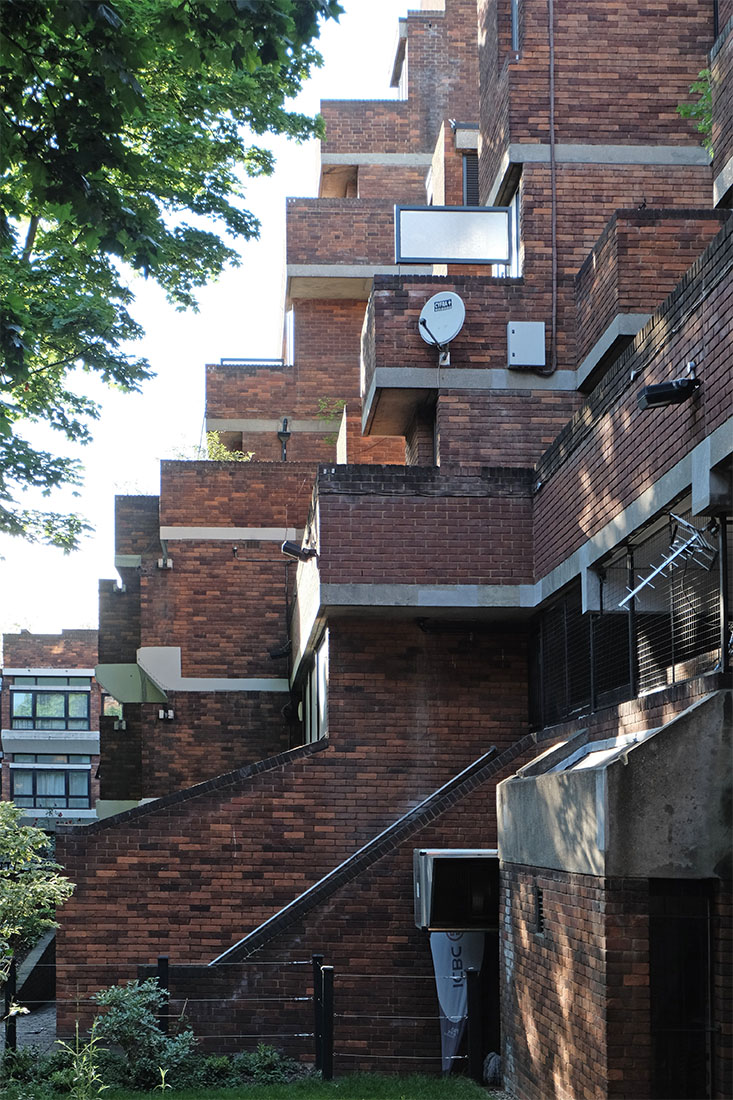 |
 |
 |
 |


Lillington Gardens
Vauxhall Bridge Road, London
1961 - 1972
The Lillington Garden Estate, designed by Darbourne & Darke, was built for the Westminster City Council, and goes back to a successful competition entry from 1961. At the time of the competition, project author John Darbourne was only 26 years old. For the realization of the large construction project, he formed a team with Geoffrey Darke. The residential estate is located in the city center, near to the Victoria train station. On the site of the Lillington Garden Estate, previously there were several run-down Victorian streets that had been severely damaged during the war. About 400 houses had to be demolished to create the space for the new constructions. The Church of St. James the Less from 1860 by George Street was preserved, and is the most important historic building in the neighborhood. The Lillington Garden Estate was realized in three stages between 1961 and 1972, and became a great success after its completion.
Characteristic for this city district is a relatively dense construction, which is interspersed by gardens and greenery. This theme was adopted by the architects, so that the design breaks with the then common pattern for social housing, consisting of compact residential units in high-rise buildings. The individuality of the residents is emphasized by the grouping of apartments and the arrangement of private gardens. With staggered terraces and internal squares, a large number of flats and maisonettes could be built without the need for a high-rise building. The layout of the different construction volumes creates a large courtyard. Due to the clever arrangement of the building volumes in fourteen independent blocks, the aesthetically attractive church tower is visible from the entire estate. The buildings are mainly three, six or eight storeys high. The complex ensemble winds its way along the Vauxhall Bridge Road, with the volume of construction jumping back and forth, rising more or less, resulting in a very plastic overall effect. By using the same red brick as in the adjacent church of St James the Less, the desired continuity between private and public buildings could be achieved. The construction consists of load-bearing brick walls as well as columns and ceilings made of reinforced concrete. The exterior walls and parapets are made of red, handcrafted brick. Careful landscaping contrasts with the expressive volumetry, creating a series of intimate green spaces. This gives this large residential development an amazingly pronounced privacy. The large number of different apartments, from the 1-room studio to the apartment with four bedrooms, offers space for around 2,000 residents in 540 apartments. The access galleries are wider on the fourth and seventh floors and are planted in a variety of ways. This creates a pedestrian passage which can also be used as a children's playground. In addition, Lillington Gardens has integrated playgrounds, a convention hall, retirement homes, medical practices and several shops and pubs. The architects have won four major awards with this development. Today the Lillington Gardens Estate is a listed site.
Das Lillington Garden Estate, entworfen von Darbourne & Darke, wurde für das Westminster City Council realisiert, und geht auf einen erfolgreichen Wettbewerbsbeitrag aus dem Jahre 1961 zurück. Zum Zeitpunkt des Wettbewerbserfolges war der Projektverfasser John Darbourne erst 26 Jahre alt. Für die Ausführung des grossen Bauvorhabens bildete er ein Team mit Geoffrey Darke. Die Wohnüberbauung befindet sich im Stadtzentrum, unweit des Victoria Bahnhof. Vor dem Bau des Lillington Garden Estate befanden sich auf dem Gelände mehrere heruntergekommene viktorianische Strassenzüge, welche während dem Krieg stark beschädigt worden waren. Es mussten 400 Häuser abgerissen werden, um den Raum für die neue Überbauung zu schaffen. Erhalten blieb dabei die Kirche St. James the Less aus dem Jahre 1860 von George Street. Das Lillington Garden Estate wurde in drei Etappen zwischen 1961 und 1972 realisiert, und wurde nach seiner Fertigstellung zu einem grossen Erfolg.
Charakteristisch für diese Gegend der Stadt ist eine relativ dichte Bebauung, welche durch Gärten und Grünanlagen aufgelockert wird. Dieses Thema wurden von den Architekten aufgenommen, so dass der Entwurf mit dem damals gängigen Muster von kompakten Wohneinheiten in Hochhäusern bricht. Die Individualität der Bewohner wird durch die Gruppierung von Wohnungen und der Anordnung von privaten Gärten betont. Mit abgetreppten Terrassen und internen Plätzen konnte eine grosse Anzahl von Geschosswohnungen und Maisonetten erstellt werden, ohne dass ein Hochhausbau erforderlich wurde. Durch die Anordnung der unterschiedlichen Bauvolumen, enstand ein grosser Innenhof. Aufgrund der geschickten Anordnung des Bauvolumens in vierzehn eigenständigen Blöcken ist der optisch reizvolle Kirchturm von der gesamten Überbauung aus sichtbar. Die Baukörper sind hauptsächlich drei-, sechs oder achtgeschossig. Die komplexe Anlage windet sich entlang der Vauxhall Bridge Road, wobei die Bauvolumen vor- und zurückspringen respektive höher und niedriger ausgebildet sind, so dass eine sehr plastische Gesamtwirkung entsteht. Durch die Verwendung des selben roten Backsteins wie bei der benachbarten Kirche St James the Less konnte die gewünschte Kontinuität zwischen den privaten und öffentlichen Bauten erreicht werden. Die Konstruktion besteht aus tragenden Backsteinwänden sowie Stützen und Decken aus Stahlbeton. Die Aussenwände und Brüstungen bestehen aus rotem, handgefertigtem Backstein. Eine sorgfältige Landschaftsgestaltung ist der expressiven Volumetrie gegenübergestellt, und erzeugt eine Reihe von intimen Grünräume. Dadurch erhält diese grosse Wohnüberbauung eine erstaunlich ausgeprägte Privatsphäre. Die grosse Anzahl unterschiedlicher Wohnungen, vom 1-Zimmer Studio bis zur Wohnung mit vier Schlafräumen, bietet in 540 Wohnungen Raum für rund 2'000 Bewohner. Die Laubengänge sind im vierten und im siebten Stockwerk breiter ausgebildet und vielfältig bepflanzt. Dadurch entsteht eine Fussgängerpassage welche auch als Kinderspielplatz genutzt werden kann. Zudem wurden in Lillington Gardens Spielplätze, eine Versammlungshalle, Alterswohnungen, Arztpraxen sowie mehrere Geschäfte und Kneipen integriert. Die Architekten haben mit dieser Überbauung vier grosse Auszeichnungen gewonnen, heute ist das Lillington Gardens Estate denkmalgeschützt.